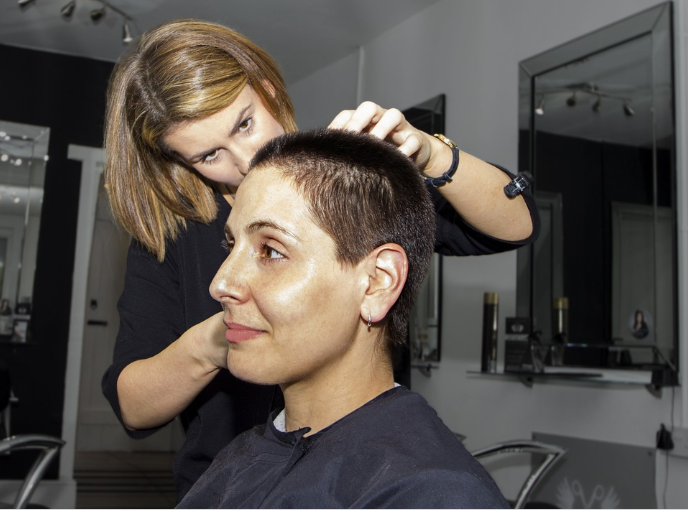Laser treatment for hair loss is a proven, effective treatment that has shown promising results. It can treat several hair conditions, including genetic hair loss, pattern balding and androgenetic alopecia in men and women.
LLLT is a low-level light therapy that stimulates the scalp, reducing inflammation and promoting new growth. It can be used independently or combined with PRP (Platelet Rich Plasma) treatments for an even more significant effect.
Reduces Hair Loss
Laser treatment is a less invasive option for men and women experiencing hair loss. It reduces hair follicles’ response to hormones that promote hair loss, like dihydrotestosterone (DHT).
It also helps stimulate hair growth by increasing blood flow to the scalp and promoting the development of healthy new hair follicles. It can be used independently or combined with PRP (Platelet Rich Plasma) treatments for added effectiveness.
During laser treatment for hair loss, a doctor places a particular device with medical-grade laser diodes onto the skin. The laser emits light and heat to disable or kill the hair follicles responsible for your hair loss.
After treatment, you might experience a small amount of redness and swelling in the treated area. The doctor might apply ice to the site to reduce any discomfort.
You can expect to have two to six treatments. The interval between treatments depends on the location and hair growth rate.
Reduces Hair Thinning
Laser treatment can reduce hair thinning in men and women who suffer from hereditary forms of hair loss, such as androgenetic alopecia or pattern baldness. It uses low-level laser therapy (LLLT), a noninvasive form of hair regrowth that promotes healthy hair growth, reduces shedding and improves overall scalp health.
LLLT works like water helps a plant grow: the laser’s energy stimulates and disperses blood supply and nutrients to the scalp, promoting regrowth. It also increases collagen production, a critical component of healthy hair.
Another noninvasive option for reducing hair thinning is Platelet Rich Plasma (PRP). This involves drawing a small amount of blood from the patient, placing it into a machine that separates it into parts, and injecting the plasma back into the thinning area.
It can be expensive and may only work for some. It would help if you had several weekly treatments for a few months to see results. It also interacts with certain medications, so consult your doctor about which ones you should avoid before the procedure.
Reduces Scalp Inflammation
Scalp inflammation can be triggered by many factors, including an overproduction of sebum that clogs the pores and hair follicles. Hormone imbalances, medical conditions or environmental exposures can cause this.
Luckily, scalp inflammation can be fought off with laser treatment. This is because LLLT has anti-inflammatory properties that reduce the number of damaged cells on your scalp and prevent them from contributing to hair loss.
The process also stimulates the epidermal stem cells and increases blood flow to the scalp, allowing more oxygen and nutrients to reach your hair follicles. It is also known to normalize the production of sebum on your scalp.
Unlike traditional treatment methods, LLLT has no side effects and is entirely safe. It is used to treat many different kinds of skin problems, including psoriasis, eczema and seborrheic dermatitis. It can also help with itching and dryness associated with alopecia areata.
Increases Blood Circulation
One of the most significant benefits of laser treatment is its ability to increase blood circulation. A weak blood supply can cause many acute and chronic health problems, including varicose veins, numbness, weakness, pain, memory loss and inflammation.
Increasing blood flow through laser treatment can boost your health and wellness by providing fresh oxygen to cells. It can also decrease inflammation and resolve pain in the affected area.
Researchers have found that the laser’s beam can trigger a compound called nitric oxide to release into the bloodstream, which makes blood vessels expand so that more blood can flow to the area that needs it. The blood flow increases the number of stem cells that can enter the site to help repair it, along with endorphins that stimulate healing.
The laser’s nitric oxide release is the same response your immune system has when encountering an injury, such as an infection or muscle damage. With a series of treatments, your body’s cells constantly get more nutrients and oxygen, so the wound heals naturally over time.
Stimulates Hair Growth
Laser hair growth therapy uses low-level lasers to stimulate the scalp and hair follicles. It is safe for people with male and female pattern baldness or androgenic alopecia, but it may not be effective for everyone.
Unlike other lasers that target pigment and damage hair follicles, LLLT helps promote new hair growth, called photobiomodulation. It can also help to restore the health of existing hair.
In addition to stimulating new hair growth, LLLT is thought to reduce or prevent inflammation in the scalp. This inflammation can cause follicles to shrink, which can further inhibit hair growth.
The light energy from LLLT stimulates hair follicles and can also increase blood flow to the scalp. This increases circulation and distributes blood and nutrients to the scalp.
Laser treatment is noninvasive, painless and has a much shorter recovery time than traditional surgery. It is also less invasive than some hair loss treatments, such as minoxidil.










